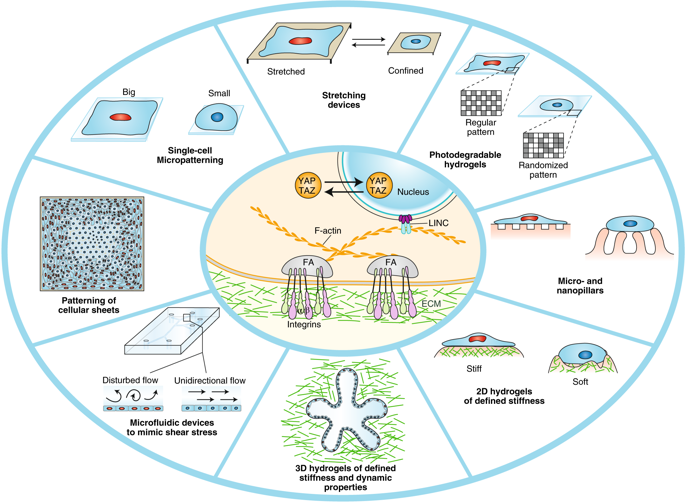当前位置:
X-MOL 学术
›
Nat. Mater.
›
论文详情
Our official English website, www.x-mol.net, welcomes your feedback! (Note: you will need to create a separate account there.)
Biomaterials and engineered microenvironments to control YAP/TAZ-dependent cell behaviour.
Nature Materials ( IF 41.2 ) Pub Date : 2018-10-29 , DOI: 10.1038/s41563-018-0180-8 Giovanna Brusatin 1 , Tito Panciera 2 , Alessandro Gandin 1, 2 , Anna Citron 2 , Stefano Piccolo 2, 3
Nature Materials ( IF 41.2 ) Pub Date : 2018-10-29 , DOI: 10.1038/s41563-018-0180-8 Giovanna Brusatin 1 , Tito Panciera 2 , Alessandro Gandin 1, 2 , Anna Citron 2 , Stefano Piccolo 2, 3
Affiliation

|
Mechanical signals are increasingly recognized as overarching regulators of cell behaviour, controlling stemness, organoid biology, tissue development and regeneration. Moreover, aberrant mechanotransduction is a driver of disease, including cancer, fibrosis and cardiovascular defects. A central question remains how cells compute a host of biomechanical signals into meaningful biological behaviours. Biomaterials and microfabrication technologies are essential to address this issue. Here we review a large body of evidence that connects diverse biomaterial-based systems to the functions of YAP/TAZ, two highly related mechanosensitive transcriptional regulators. YAP/TAZ orchestrate the response to a suite of engineered microenviroments, emerging as a universal control system for cells in two and three dimensions, in static or dynamic fashions, over a range of elastic and viscoelastic stimuli, from solid to fluid states. This approach may guide the rational design of technological and material-based platforms with dramatically improved functionalities and inform the generation of new biomaterials for regenerative medicine applications.
中文翻译:

控制 YAP/TAZ 依赖性细胞行为的生物材料和工程微环境。
机械信号越来越多地被认为是细胞行为、控制干性、类器官生物学、组织发育和再生的首要调节器。此外,异常的机械传导是疾病的驱动因素,包括癌症、纤维化和心血管缺陷。一个核心问题仍然是细胞如何将大量生物力学信号计算为有意义的生物行为。生物材料和微细加工技术对于解决这一问题至关重要。在这里,我们回顾了大量的证据,这些证据将不同的基于生物材料的系统与 YAP/TAZ(两个高度相关的机械敏感转录调节因子)的功能联系起来。YAP/TAZ 协调对一套工程微环境的响应,以静态或动态方式成为二维和三维细胞的通用控制系统,在一系列弹性和粘弹性刺激上,从固态到液态。这种方法可以指导技术和基于材料的平台的合理设计,并显着改善功能,并为再生医学应用的新生物材料的生成提供信息。
更新日期:2018-12-10
中文翻译:

控制 YAP/TAZ 依赖性细胞行为的生物材料和工程微环境。
机械信号越来越多地被认为是细胞行为、控制干性、类器官生物学、组织发育和再生的首要调节器。此外,异常的机械传导是疾病的驱动因素,包括癌症、纤维化和心血管缺陷。一个核心问题仍然是细胞如何将大量生物力学信号计算为有意义的生物行为。生物材料和微细加工技术对于解决这一问题至关重要。在这里,我们回顾了大量的证据,这些证据将不同的基于生物材料的系统与 YAP/TAZ(两个高度相关的机械敏感转录调节因子)的功能联系起来。YAP/TAZ 协调对一套工程微环境的响应,以静态或动态方式成为二维和三维细胞的通用控制系统,在一系列弹性和粘弹性刺激上,从固态到液态。这种方法可以指导技术和基于材料的平台的合理设计,并显着改善功能,并为再生医学应用的新生物材料的生成提供信息。



























 京公网安备 11010802027423号
京公网安备 11010802027423号